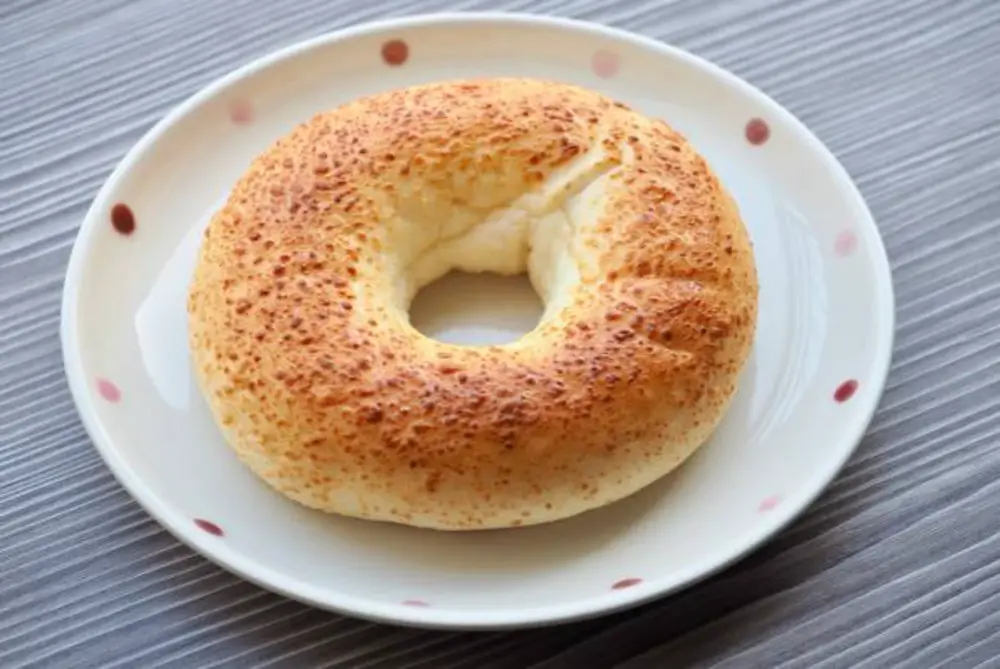
Homemade Sourdough Bagels Recipe
In just 10 minutes of prep time, this simple overnight recipe utilizes active sourdough starter to craft the perfect soft and chewy NY-style bagels. Personalize your bagels with zesty everything bagel spice, sesame seeds, and more! This recipe is adapted from my bestselling book, Artisan Sourdough Made Simple.
Print
Pin
Ingredients
For the Dough
- 150 g 3/4 cup bubbly, active sourdough starter
- 500 g 4 cups plus 2 tbsp King Arthur bread flour
- 250 g 1 cup plus 2 tsp warm water (see notes below for temperature range)
- 24 g 2 tbsp granulated sugar
- 9 g 1 1/2 tsp fine sea salt
- Cooking spray or oil for coating the plastic wrap
For the Water Bath
- 20 g 1 tbsp honey
Toppings
- Mixed seeds such as poppy, sesame, fennel, flax, and sunflower seeds, or Everything Bagel Spice
Instructions
- Make the Dough: In a large mixing bowl, combine the sourdough starter, warm water, and sugar with a fork until blended. Add the flour and salt to form a rough dough, then continue mixing by hand until the dough is free of lumps. This dough will be quite stiff and dry. Ensure you use a large bowl, as the dough will rise significantly. Alternatively, you can use a stand mixer fitted with a dough hook, mixing on low speed for 5-6 minutes to knead the dough.
- Cover the dough with a damp towel and let it rest for 45 minutes to 1 hour. After resting, shape the dough into a semi-smooth ball, which should take about 15-20 seconds.
- Bulk Rise: Lightly coat plastic wrap with oil to prevent sticking, then cover the bowl with it. Allow the dough to rise until it doubles in size, which takes approximately 10-12 hours at 68°F (20°C) or 8-10 hours at 70°F (21°C). In warmer temperatures, let the dough rise during the day. Once nearly doubled, cover the bowl and refrigerate overnight, as the dough will continue to rise slightly in the fridge. Use the chilled dough the next day.
- Shape: Line a baking sheet with a nonstick silicone mat or parchment paper. If using parchment, lightly spray or oil it to prevent sticking.
- Transfer the dough to a non-floured work surface. Flatten it into a rectangle and divide it into 8 equal pieces, approximately 115 g (4 oz) each. Gather the edges, flip the dough over, and shape each piece into a ball. Let the dough balls rest on the prepared baking sheet for 10-15 minutes to relax the gluten.
- Working with one dough ball at a time, poke a hole through the center. Gently stretch the dough in a circular motion until the hole is about the size of a walnut. Alternatively, you can lift the dough, insert both index fingers through the hole, and barrel roll to stretch it. Place the shaped dough back on the baking sheet, repeating with the remaining pieces.
- Second Rise: Cover the shaped dough with a damp towel and let it rest at room temperature for 15-20 minutes, allowing it to puff up slightly.
- Meanwhile, bring a medium pot of water to a boil. Add the honey and whisk until dissolved. Preheat your oven to 425°F (220°C). Prepare a rimmed tray or shallow bowl with the mixed seeds.
- Boil the Bagels: Carefully place 2-3 bagels into the boiling water and simmer for 30 seconds on each side for a thin crust. If using cold dough, the bagels may not float immediately; gently nudge them after 30 seconds. Using a slotted spoon, transfer the boiled bagels back to the baking sheet, rounded side up.
- While the bagels are still slightly warm but not fully cooled, dip the rounded side into the seeds to coat. Return them to the baking sheet and finish boiling the remaining bagels.
- Bake: Place the baking sheet in the center of the oven and bake the bagels for 20-25 minutes. Flip them over briefly to cook the bottom side for 1-2 minutes. The bagels should be puffed up, light golden brown, and light to the touch. Transfer to a wire rack to cool slightly, but enjoy one (or two) while they're warm.